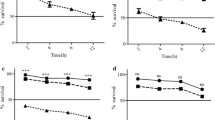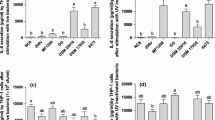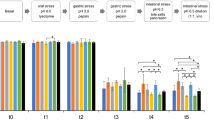Abstract
The discovery of the potential of paraprobiotics to exert different immunological benefits suggests that further studies should be carried out to determine their potential and mechanisms of action in modulating the immune system. The objective of this study was to investigate the immune response of several microbial-associated molecular patterns (MAMPS) used at different doses in macrophage cell lines RAW-264.7 stimulated with lipopolysaccharide (LPS). Two experiments were conducted. The first was performed to determine a dose response curve for each paraprobiotic (Bifidobacterium lactis, Lactobacillus casei, Lactobacillus gasseri, Lactobacillus paracasei, and Streptococcus thermophilus). Further experiments were carried using only two doses (0.01 g/ml and 0.1 g/ml). RAW-264.7 cells were cultivated in Dubelcco’s Modified Eagle’s medium supplemented with fetal bovine serum and penicillin/streptomycin. Cells were incubated with LPS (1 μg/ml) and six concentrations of MAMPs were added. RAW-264.7 viability, myeloperoxidase activity, nitrite/nitrate concentration, reactive oxygen species production, oxidative damage, and inflammatory parameters were measured. In the LPS group, there was a significant reduction in cell viability. Myeloperoxidase and nitrite/nitrate concentrations demonstrated a better effect at 0.01 and 0.1 g/ml doses. There was a significant reduction in interleukin-6 (IL-6) levels at 0.1 g/ml dose in all paraprobiotics. IL-10 levels decreased in the LPS group and increased at 0.1 g/ml dose in all paraprobiotics. The dichlorofluorescin diacetate results were reinforced by the observed in oxidative damage. Paraprobiotics are likely to contribute to the improvement of intestinal homeostasis, immunomodulation, and host metabolism.
Graphical Abstract






Similar content being viewed by others
References
Iacono A, Raso GM, Canani RB, Calignano A, Meli R (2011) Probiotics as an emerging therapeutic strategy to treat NAFLD: focus on molecular and biochemical mechanisms. J Nutr Biochem 22(8):699–711. https://doi.org/10.1016/j.jnutbio.2010.10.002
Taverniti V, Guglielmetti S (2011) The immunomodulatory properties of probiotic microorganisms beyond their viability (ghost probiotics: proposal of paraprobiotic concept). Genes Nutr 6:261–274. https://doi.org/10.1007/s12263-011-0218-x
Moro-García MA, Alonso-Arias R, Baltadjieva M, Benítez CF, Barrial MAF, Ruisánchez ED et al (2013) Oral supplementation with Lactobacillus delbrueckii subsp. bulgaricus 8481 enhances systemic immunity in elderly subjects. Age 35:1311–1326. https://doi.org/10.1007/s11357-012-9434-6
Nithya V, Muthukumar SP, Halami PM (2012) Safety assessment of Bacillus licheniformis Me1 isolated from milk for probiotic application. Int J Toxicol 31:228–237. https://doi.org/10.1177/1091581812443388
Li J, Zhang W, Wang C, Yu Q, Dai R, Pei X (2012) Lactococcus lactis expressing food-grade β-galactosidase alleviates lactose intolerance symptoms in post-weaning Balb/c mice. Appl Microbiol Biotechnol 96:1499–1506. https://doi.org/10.1007/s00253-012-3977-4
Sudha MR, Bhonagiri S, Kumar MA (2013) Efficacy of Bacillus clausii strain UBBC-07 in the treatment of patients suffering from acute diarrhea. Benef Microbes 4:211–216. https://doi.org/10.3920/BM2012.0034
Sugimoto S, Ishii Y, Izama N, Masuoka N, Kano M, Sone T et al (2012) Photoprotective effects of Bifidobacterium breve supplementation against skin damage induced by ultraviolet irradiation in hairless mice. Photodermatol Photoimmunol Photomed 28:312–319. https://doi.org/10.1111/phpp.12006
Ducrotte P, Sawant P, Jayanthi V (2012) Clinical trial: Lactobacillus plantarum 299v (DSM 9843) improves symptoms of irritable bowel syndrome. World J Gastroenterol 18:4012–4018. https://doi.org/10.3748/wjg.v18.i30.4012
Amdekar S, Singh V, Singh DD (2011) Probiotic therapy: immunomodulating approach toward urinary tract infection. Curr Microbiol 63:484–490. https://doi.org/10.1007/s00284-011-0006-2
Borges S, Barbosa J, Silva J, Texeira P (2013) Evaluation of characteristics of Pediococcus spp. to be used as a vaginal probiotic. J Appl Microbiol 115:527–538. https://doi.org/10.1111/jam.12232
Teanpaisan R, Piwat S (2014) Lactobacillus paracasei SD1, a novel probiotic, reduces mutans streptococci in human volunteers: a randomized placebo-controlled trial. Clin Oral Investing 18(3):857–862. https://doi.org/10.1007/s00784-013-1057-5
Bordoni A, Amaretti A, Leonardi A, Boschetti E, Danesi F, Matteuzzi D et al (2013) Cholesterol-lowering probiotics: in vitro selection and in vivo testing of bifidobacteria. Appl Microbiol Biotechnol 97:8273–8281. https://doi.org/10.1007/s00253-013-5088-2
Almada CN (2017) Paraprobiotics: impact of inactivation methods on their efficacy, stability in food and health benefits = Paraprobióticos: impacto de métodos de inativação sobre a eficácia, estabilidade em alimentos e efeitos benéficos à saúde. Tese—Universidade Estadual de Campinas (UNICAMP), p 166
Aguilar-Toalá JE, Garcia-Varela R, Garcia HS, Mata-Haro V, González-Córdova AF, Vallejo-Cordoba B et al (2018) Postbiotics: An evolving term within the functional foods field. Trends Food Sci Technol 75:105–114. https://doi.org/10.1016/j.tifs.2018.03.009
Kawai T, Akira S (2011) Toll-like receptors and their crosstalk with other innate receptors in infection and immunity. Immunity 34:637–650. https://doi.org/10.1016/j.immuni.2011.05.006
Underhill DM, Ozinsky A, Hajjar AM, Stevens A, Wilson CB, Bassetti M et al (1999) The Toll-like receptor 2 is recruited to macrophage phagosomes and discriminates between pathogens. Nature 401:811–815. https://doi.org/10.1038/44605
Campos MA, Almeida IC, Takeuchi O, Akira S, Valente EP, Procopio DO et al (2001) Activation of toll-like receptor-2 by glycosylphosphatidylinositol anchors from a protozoan parasite. J Immunol 167:416–423. https://doi.org/10.4049/jimmunol.167.1.416
Janeway CA (2001) How the immune system protects the host from infection. Microb Infect 3:1167–1171. https://doi.org/10.1016/s1286-4579(01)01477-0
Janeway CA, Medzhitov R (2002) Innate immune recognition. Annu Rev Immunol 20:197–216. https://doi.org/10.1146/annurev.immunol.20.083001.084359
Sellge G, Kufer TA (2015) PRR-signaling pathways: learning from microbial tactics. Semin Immunol 27(2):75–84. https://doi.org/10.1016/j.smim.2015.03.009
Girbes ARJ, Beishuizen A, van Schijndel RJMS (2008) Pharmacological treatment of sepsis. Fund Clin Pharmacol 22:355–361. https://doi.org/10.1111/j.1472-8206.2008.00606.x
Dong D, Zhou NN, Liu RX, Xiong JW, Pan H, Sun SQ et al (2017) Sarsasapogenin-AA13 inhibits LPS-induced inflammatory responses in macrophage cells in vitro and relieves dimethylbenzene-induced ear edema in mice. Acta Pharmacol Sin 38(5):699–709. https://doi.org/10.1038/aps.2016.180
Souza NC, de Oliveira Nascimento EN, de Oliveira IB, Oliveira HML, Santos EGP, Moreira Cavalcanti Mata MER, Gelain DP, Moreira JCF, Dalmolin RJS, de Bittencourt Pasquali MA (2020) Anti-inflammatory and antixidant properties of blend formulated with compounds of Malpighia emarginata DC (acerola) and Camellia sinensis L. (green tea) in lipopolysaccharide-stimulated RAW 2647 macrophages. Biomed Pharmacother 128:110277. https://doi.org/10.1016/j.biopha.2020.110277
Souza NC, de Oliveira JM, Morrone MDS et al (2017) Antioxidant and anti-inflammatory properties of Anacardium occidentale leaf extract. Evid Based Complement Altern Med. https://doi.org/10.1155/2017/2787308
Aranda A, Sequedo L, Tolosa L, Quintas G, Burello E, Castell JV et al (2013) Dichloro-dihydro-fluorescein diacetate (DCFH-DA) assay: a quantitative method for oxidative stress assessment of nanoparticle-treated cells. Toxicol In Vitro 27(2):954–963. https://doi.org/10.1016/j.tiv.2013.01.016
Levine RL, Garland D, Oliver CN, Amici A, Climent I, Lenz AG et al (1990) Determination of carbonyl content in oxidatively modified proteins. Methods Enzymol 186:464–478. https://doi.org/10.1016/0076-6879(90)86141-h
Draper HH, Hadley M (1990) Malondialdehyde determination as índex of lipid peroxidation. Methods Enzymol 186:421–431. https://doi.org/10.1016/0076-6879(90)86135-i
Green LC, Wagner DA, Glogowski J, Skipper PL, Wishnok JS, Tannenbaum SR (1982) Analysis of nitrate, nitrite and nitrate in biological fluids. Anal Biochem 126:131–138. https://doi.org/10.1016/0003-2697(82)90118-x
De Young LM, Kheifets JB, Ballaron SJ, Young JM (1989) Edema and cell infiltration in the phorbol ester-treated mouse ear are temporally separate and can be differentially modulated by pharmacologic agents. Agents Actions 26:335–341. https://doi.org/10.1007/BF01967298
Comim CM, Cassol OJ Jr, Constantino LS, Felisberto F, Petronilho F, Rezin GT, Scaini G, Daufenbach JF, Streck EL, Quevedo J, Dal-Pizzol F (2011) Alterations in inflammatory mediators, oxidative stress parameters and energetic metabolism in the brain of sepsis survivor rats. Neurochem Res 36(2):304–311. https://doi.org/10.1007/s11064-010-0320-2
Nitkin CR, Bonfield TL (2017) Balancing anti-inflammatory and anti-oxidant responses in murine bone marrow derived macrophages. PLoS ONE 12(9):e0184469. https://doi.org/10.1371/journal.pone.0184469
Sabroe I, Read RC, Whyte MK, Dockrell DH, Vogel SN, Dower SK (2003) Toll-like receptors in health and disease: complex questions remain. J Immunol 171(4):1630–1635. https://doi.org/10.4049/jimmunol.171.4.1630
Borderie D, Hilliquin P, Hernvann A, Lemarechal H, Kahan A, Menkes CJ et al (2002) Inhibition of inducible NO synthase by TH2 cytokines and TGF beta in rheumatoid arthritic synoviocytes: effects on nitrosothiol production. Nitric Oxide 6(3):271–282. https://doi.org/10.1006/niox.2001.0418
Kaarlola A, Tallgren M, Pettila V (2006) Long-term survival, quality of life, and quality-adjusted life-years among critically ill elderly patients. Crit Care Med 34:2120–2126. https://doi.org/10.1097/01.CCM.0000227656.31911.2E
Falciglia M, Freyberg RW, Almenoff PL, D’Alessio DA, Render ML (2009) Hyperglycemia–related mortality in critically ill patients varies with admission diagnosis. Crit Care Med 37:3001–3009. https://doi.org/10.1097/CCM.0b013e3181b083f7
Nelson WG, De Marzo AM, DeWeese TL, Isaacs WB (2004) The role of inflammation in the pathogenesis of prostate cancer. J Urol 172(5 Pt 2):S6–S12. https://doi.org/10.1097/01.ju.0000142058.99614.ff
Daly BJ, Douglas SL, Kelley CG, O’Toole E, Montenegro H (2005) Trial of a disease management program to reduce hospital readmissions of the chronically critically ill. Chest 128:507–517. https://doi.org/10.1378/chest.128.2.507
Ouwehand AC, Tölkkö S, Kulmala J, Salminen S, Salminen E (2000) Adhesion of inactivated probiotic strains to intestinal mucus. Lett Appl Microbiol 31:82–86. https://doi.org/10.1046/j.1472-765x.2000.00773.x
Donkor ON, Ravikumar M, Proudfoot O, Day SL, Apostolopoulos V, Paukovics G et al (2012) Cytokine profile and induction of T helper type 17 and regulatory T cells by human peripheral mononuclear cells after microbial exposure. Clin Exp Immunol 167:282–295. https://doi.org/10.1111/j.1365-2249.2011.04496.x
Szajewska H, Guarino A, Hojsak I, Indrio F, Kolacek S, Shamir R et al (2014) European Society for Pediatric Gastroenterology, Hepatology, and Nutrition. Use of probiotics for management of acute gastroenteritis: a position paper by the ESPGHAN working group for probiotics and prebiotics. J Pediatr Gastroenterol Nutr 58:531–539. https://doi.org/10.1097/MPG.0000000000000320
Nakamura Y, Terahara M, Iwamoto T, Yamada K, Asano M, Kakuta S et al (2012) Upregulation of polymeric immunoglobulin receptor expression by the heat-inactivated potential probiotic Bifidobacterium bifidum OLB6378 in a mouse intestinal explant model. Scand J Immunol 75:176–183. https://doi.org/10.1111/j.1365-3083.2011.02645.x
Schwendicke F, Horb K, Kneist S, Dörfer C, Paris S (2014) Effects of heat-inactivated Bifidobacterium BB12 on cariogenicity of Streptococcus mutans in vitro. Arch Oral Biol 59:1384–1390. https://doi.org/10.1016/j.archoralbio.2014.08.012
Sugahara H, Yao R, Odamaki T, Xiao JZ (2017) Differences between live and heat-killed Bifidobacteria in the regulation of immune function and the intestinal environment. Benef Microbes 8:463–472. https://doi.org/10.3920/BM2016.0158
Ávila PRM, Michels M, Vuolo F, Bilésimo R, Burger H, Milioli MVM et al (2020) Protective effects of fecal microbiota transplantation in sepsis are independent of the modulation of the intestinal flora. Nutrition 73:110727. https://doi.org/10.1016/j.nut.2020.110727
Cross ML, Ganner A, Teilab D, Fray LM (2004) Patterns of cytokine induction by gram-positive and gram-negative probiotic bacteria. FEMS Immunol Med Microbiol 42(2):173–180. https://doi.org/10.1016/j.femsim.2004.04.001
Del Carmen S, de Moreno de LeBlanc A, Martin R, Chain F, Langella P, Bermúdez-Humarán LG et al (2014) Genetically engineered immunomodulatory Streptococcus thermophilus strains producing antioxidant enzymes exhibit enhanced anti-inflammatory activities. Appl Environ Microbiol 80(3):869–877. https://doi.org/10.1128/AEM.03296-13
del Carmen S, Miyoshi A, Azevedo V, de Moreno de LeBlanc A, LeBlanc JG (2015) Evaluation of a Streptococcus thermophilus strain with innate anti-inflammatory properties as a vehicle for IL-10 cDNA delivery in an acute colitis model. Cytokine 73(2):177–183. https://doi.org/10.1016/j.cyto.2015.02.020
Tejada-Simon MV, Pestka JJ (1999) Proinflammatory cytokine and nitric oxide induction in murine macrophages by cell wall and cytoplasmic extracts of lactic acid bacteria. J Food Protect 62(12):1435–1444. https://doi.org/10.4315/0362-028x-62.12.1435
Adams CA (2010) The probiotic paradox: live and dead cells are biological response modifiers. Nutr Res Rev 23(1):37–46. https://doi.org/10.1017/S0954422410000090
Valko M, Rhodes CJ, Moncol J, Izakovic M, Mazur M (2006) Free radicals, metals and antioxidants in oxidative stress-induced cancer. Chem Biol Interact 160:1–40. https://doi.org/10.1016/j.cbi.2005.12.009
Sinha K, Das J, Pal PB, Sil PC (2013) Oxidative stress: the mitochondria-dependent and mitochondria-independent pathways of apoptosis. Arch Toxicol 87(7):1157–1180. https://doi.org/10.1007/s00204-013-1034-4
Songisepp E, Kals J, Kullisaar T, Mandar R, Hutt P, Zilmer M, Mikelsaar M (2005) Evaluation of the functional efficacy of an antioxidative probiotic in healthy volunteers. Nutr J 4:22. https://doi.org/10.1186/1475-2891-4-22
Amaretti A, Di Nunzio M, Pompei A, Raimondi S, Rossi M, Bordoni A (2013) Antioxidant properties of potentially probiotic bacteria: in vitro and in vivo activities. Appl Microbiol Biotechnol 97:809–817. https://doi.org/10.1007/s00253-012-4241-7
Kapila S, Kapila R, Reddi S, Sinha PR (2014) Oral administration of probiotic Lactobacillus casei spp. casei ameliorates oxidative stress in rats. Int J Curr Microbiol Appl Sci. 3:670–684
Mishra V, Shah C, Mokashe N, Chavan R, Yadav H, Prajapati J (2015) Probiotics as potential antioxidants: a systematic review. J Agric Food Chem 63:3615–3626. https://doi.org/10.1021/jf506326t
Kleniewska P, Hoffmann A, Pniewska E, Pawliczak R (2016) The influence of probiotic Lactobacillus casei in combination with prebiotic inulin on the antioxidant capacity of human plasma. Oxid Med Cell Longev 2016:1340903. https://doi.org/10.1155/2016/1340903
Wang Y, Wu Y, Wang Y, Fu A, Gong L, Li W et al (2017) Bacillus amyloliquefaciens SC06 alleviates the oxidative stress of IPEC-1 via modulating Nrf2/Keap1 signaling pathway and decreasing ROS production. Appl Microbiol Biotechnol 101(7):3015–3026. https://doi.org/10.1007/s00253-016-8032-4
Moshage H, Kok B, Huizenga JR, Jansen PL (1995) Nitrite and nitrate determination in plasma: a critical evaluation. Clin Chem 41:892–896
Hausladen A, Stamler JS (1999) Nitrosative stress. Methods Enzymol 300:389–395. https://doi.org/10.1016/s0076-6879(99)00143-3
Murphy MP (1999) Nitric oxide and cell death. Biochem Biophys Acta 1411:401–414. https://doi.org/10.1016/s0005-2728(99)00029-8
Zhao BB, Meng J, Zhang QX, Kang TT, Lu RR (2017) Protective effect of surface layer proteins isolated from four Lactobacillus strains on hydrogen-peroxide-induced HT-29 cells oxidative stress. Int J Biol Macromol 102:76–83. https://doi.org/10.1016/j.ijbiomac.2017.03.160
Xing JL, Wang G, Zhang QX, Liu X, Yin B, Fang D et al (2015) Determining antioxidant activities of lactobacilli by cellular antioxidant assay in mammal cells. Funct Foods 19:554–562. https://doi.org/10.1371/journal.pone.0119058
Magistrelli L, Amoruso A, Mogna L, Graziano T, Cantello R, Pane M et al (2019) Probiotics may have beneficial effects in Parkinson’s disease: in vitro evidence. Front Immunol 10:969. https://doi.org/10.3389/fimmu.2019.00969
Warshakoon HJ, Hood JD, Kimbrell MR, Malladi S, Wu WY, Shukla NM (2009) Potential adjuvantic properties of innate immune stimuli. Hum Vaccin 5:381–394. https://doi.org/10.4161/hv.5.6.8175
Acknowledgements
UNESC and Gabbia Biotechnology
Funding
Gabbia Biotechnology and UNESC.
Author information
Authors and Affiliations
Contributions
MM contributed to experimental planning, data collection, data analysis, and writing of paper. GFAJ contributed to experimental planning and data analysis. APLV, MR, and FR contributed to experimental planning. EC and PF contributed to data collection and data analysis. DG and FDP contributed to experimental planning, data analysis, and writing of the paper.
Corresponding author
Ethics declarations
Conflict of interests
Gabbia Biotechnology is developing paraprobiotics for the commercial purposes. Gabriel Jesus, Marina Rosseto, and Ana Paula Voytena are members of Gabbia Biotechnology. The authors declared no potential conflicts of interest with respect to the research, authorship, and/or publication of this article.
Consent to Publication
We confirm that the manuscript has been read and approved by all named authors and that there are no other persons who satisfied the criteria for authorship, but are not listed. We further confirm that the order of authors listed in the manuscript has been approved by all of us.
Data Availability
Data will be made available on reasonable request.
Additional information
Publisher's Note
Springer Nature remains neutral with regard to jurisdictional claims in published maps and institutional affiliations.
Supplementary Information
Below is the link to the electronic supplementary material.
Rights and permissions
About this article
Cite this article
Michels, M., Jesus, G.F.A., Voytena, A.P.L. et al. Immunomodulatory Effect of Bifidobacterium, Lactobacillus, and Streptococcus Strains of Paraprobiotics in Lipopolysaccharide-Stimulated Inflammatory Responses in RAW-264.7 Macrophages. Curr Microbiol 79, 9 (2022). https://doi.org/10.1007/s00284-021-02708-1
Received:
Accepted:
Published:
DOI: https://doi.org/10.1007/s00284-021-02708-1




